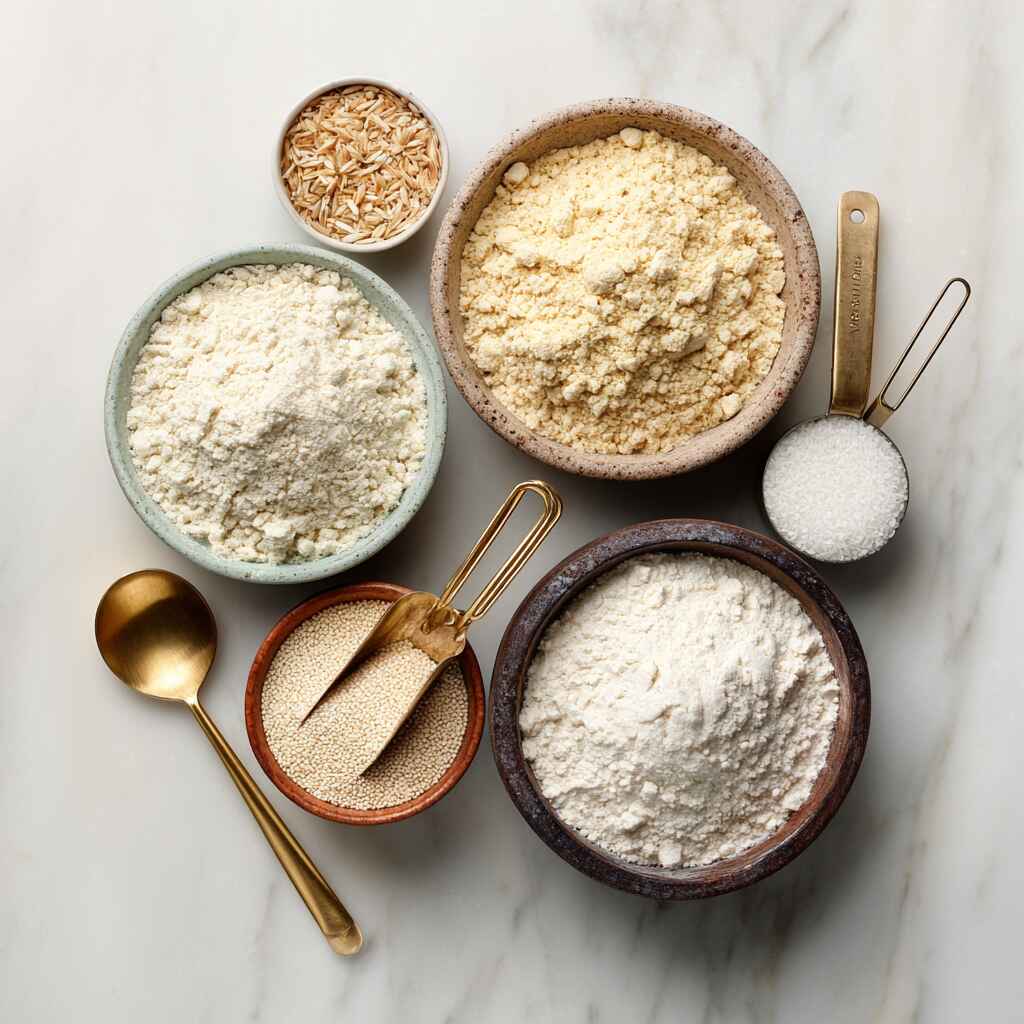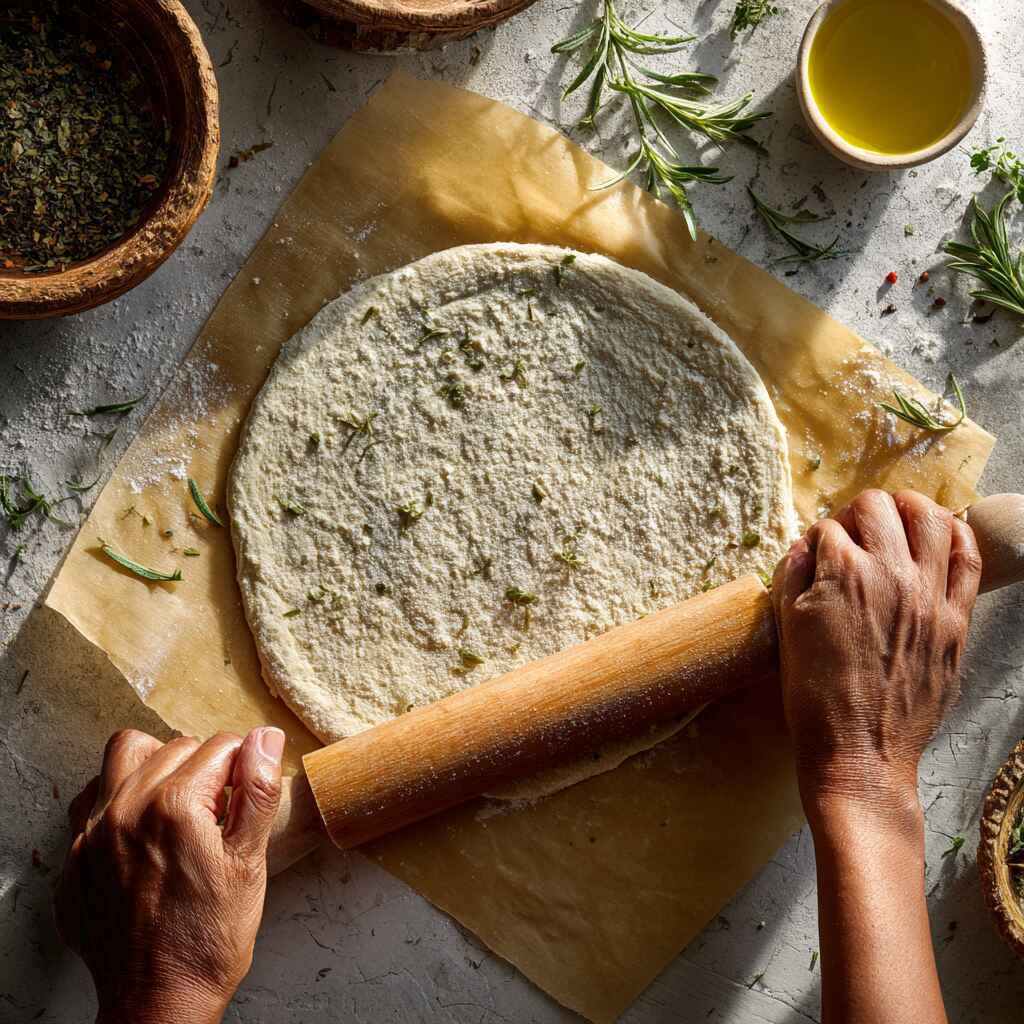Craving that perfect crunch in your pizza but need to skip the gluten? This crispy pizza dough recipe (gluten-free) is your answer. Designed for those with gluten intolerance, celiac disease, or anyone just looking to clean up their ingredients, this recipe delivers a crust that’s crispy on the outside and tender inside—without the sogginess or bland texture that gluten-free versions often bring.
Making a gluten-free crispy pizza dough isn’t about simply swapping flour. It’s a delicate process that involves choosing the right flour blends, adding texture-boosting ingredients like psyllium husk or xanthan gum, and following techniques that lock in crunch. From the mixing bowl to the oven rack, every step affects your results.
Whether you’re new to gluten-free cooking or you’re just trying to nail that pizzeria-style crisp at home, this guide has you covered. We’ll walk you through every detail of the crispy pizza dough recipe (gluten-free)—with options for almond flour, dairy-free tweaks, and baking secrets for consistent results.
Looking for inspiration? Try this keto cottage cheese egg pizza crust, a low-carb, gluten-free favorite.
Get ready to master a dough that’s full of flavor, gluten-free, and seriously crisp.
Table of Contents
Understanding Crispy Gluten-Free Pizza Dough
What Makes Pizza Dough Crispy Yet Gluten-Free?
If you’re after a homemade crispy pizza dough recipe that’s also gluten-free, you’ve probably discovered how tricky it is to get that satisfying crunch without traditional flour. Gluten helps trap air and create chew, but gluten-free flours behave differently. That’s why crafting the right crispy pizza dough recipe takes more than swapping ingredients—it’s a science.
To build crispiness, your dough needs a precise mix of gluten-free flours, starches like tapioca or arrowroot, and structure-boosting ingredients such as xanthan gum or psyllium husk. Without these, the crust often turns soggy or falls apart. When done right, a gluten-free crust can turn out beautifully browned, crunchy on the outside, and soft in the middle.
This guide gives you every detail you need to master a foolproof crispy pizza dough recipe that’s gluten-free, easy to handle, and actually enjoyable to eat.
Common Challenges When Using Gluten-Free Flours
Flour swaps aren’t always enough. One of the most common issues in any crispy pizza dough recipe without gluten is getting the moisture right. Too much water creates a gummy crust. Too little and the dough cracks. With the right ingredients and balance, your crispy pizza dough recipe can rival any pizzeria.
Need help with gluten-free flour techniques? Check out this gluten-free sourdough bread guide.
Choosing the Right Gluten-Free Flours for Crispiness
Top Gluten-Free Flours for Crisp Texture (Almond, Rice, Tapioca, etc.)
Getting the flour right is step one in any successful crispy pizza dough recipe. While traditional pizza dough depends on gluten for chew and structure, your gluten-free version will rely on flour blends that offer texture, flexibility, and crunch.
Here’s a breakdown of top gluten-free flours to use:
| Flour Type | What It Adds | Best Usage Ratio |
|---|---|---|
| Almond Flour | Rich flavor, browning | 1 part |
| Tapioca Starch | Lightness, stretch | ½ part |
| Rice Flour | Crunch, neutral taste | 1 part |
| Sorghum Flour | Structure, protein | ½ part |
| Arrowroot Powder | Crisp finish, moisture control | ¼ part |
A good flour blend uses at least two to three flours. Almond and rice form a solid base, while tapioca or arrowroot adds that essential crunch.
Print
Crispy Pizza Dough Recipe (Gluten-Free)
- Total Time: 35 minutes
- Yield: 1 12-inch pizza (serves 2–4)
- Diet: Gluten Free
Description
This crispy pizza dough recipe is a gluten-free twist on the classic Italian crust—light, golden, and perfectly crisp. Made with a mix of gluten-free flours and texture-boosting ingredients, this dough bakes beautifully every time. Whether you’re avoiding gluten for health reasons or simply exploring new flours, this recipe delivers crunch, flexibility, and flavor without compromise. Ideal for thin-crust lovers, it’s easy to shape, holds toppings well, and finishes with a satisfying bite.
Ingredients
1 cup almond flour
1 cup white rice flour
½ cup tapioca starch
1 tbsp psyllium husk powder or 1 tsp xanthan gum
1 tsp sea salt
1 tbsp olive oil
1 tsp apple cider vinegar
¾ cup warm water (add gradually)
1 tsp garlic powder (optional, for flavor)
½ tsp dried oregano or Italian seasoning (optional)
Instructions
Preheat oven to 475°F (245°C). If using a pizza stone, place it inside the oven while preheating.
Mix dry ingredients in a large bowl: almond flour, rice flour, tapioca starch, psyllium husk, salt, and optional seasonings.
Add wet ingredients: Pour in olive oil, vinegar, and about ¾ of the warm water. Stir until dough forms. If too dry, add remaining water a tablespoon at a time. Dough should be soft, moist, and slightly sticky.
Rest the dough: Cover the bowl with a towel and let the dough rest for 30 minutes. This helps hydrate the flours and bind the dough.
Shape the dough: Place dough on parchment paper. Use lightly oiled hands or a rolling pin to flatten into a 10–12″ round, about ¼ inch thick.
Pre-bake the crust: Transfer the parchment with the dough onto a baking sheet or hot pizza stone. Bake for 8–10 minutes until lightly golden.
Add toppings: Remove from oven, add sauce, cheese, and toppings of your choice.
Final bake: Return to oven and bake an additional 8–12 minutes, or until crust edges are crisp and cheese is bubbly.
Cool slightly before slicing and serving.
Notes
For extra crunch, sprinkle cornmeal or rice flour under the dough before baking.
If using a pizza stone, let it preheat for at least 30 minutes.
Dough can be made ahead and stored in the fridge for up to 3 days.
You can replace almond flour with sunflower seed flour for a nut-free version.
Add fresh herbs like thyme or rosemary to the dough for a gourmet touch.
This crust pairs perfectly with vegan cheese, roasted veggies, or a drizzle of pesto.
- Prep Time: 15 minutes
- Cook Time: 20 minutes
- Category: Main Dish
- Method: Baking
- Cuisine: Italian-Inspired
If your crispy pizza dough recipe has been falling short, chances are the flour blend is either too heavy (causing sogginess) or too fine (making it crumbly).
Looking for inspiration? Try this simple guacamole recipe – gluten-free to pair with your next pizza night!
Comparing Store-Bought Mixes vs DIY Gluten-Free Flour Blends

Pre-made gluten-free flour blends are convenient, but they’re not always designed for pizza. Many contain xanthan gum, but lack the right ratio of starch to protein needed for crispiness.
Store-Bought Mix Pros:
- Time-saving
- Often includes binders
- Good for beginners
DIY Blend Pros:
- Fully customizable for a crispy finish
- Control over flavor and texture
- Typically more cost-effective
For a custom crispy pizza dough recipe, we recommend making your own blend tailored to your baking method. A mix of almond flour, tapioca starch, and rice flour gives a reliable base to work with.
And if you’re looking for a creamy topping, don’t miss our cheddar cheese sauce—it pairs perfectly with a crunchy crust.
Essential Ingredients to Boost Crispiness
Why Olive Oil and Xanthan Gum Matter in the Texture
The success of any crispy pizza dough recipe depends heavily on the right supporting ingredients—not just the flour. Two of the most critical additions for texture are olive oil and xanthan gum.
Olive oil helps develop a golden, crisp outer layer during baking. It also prevents dryness by sealing in moisture without making the crust soggy. You’ll want to add at least 1–2 tablespoons to your dough mixture for both flavor and texture.
Xanthan gum is the key player when it comes to structure. Since there’s no gluten, xanthan gum acts as the binding agent, giving your dough stretch and strength. Without it, the dough can fall apart or bake unevenly.
In a crispy pizza dough recipe, these two ingredients work together to hold the crust in shape and encourage even browning. The result? A crust that’s crisp, chewy, and doesn’t crack.
Discover great ideas like this vegan bacon recipe to use as a topping on your finished pizza.
The Role of Psyllium Husk, Vinegar, and Starch Blends
Beyond olive oil and xanthan gum, other ingredients can supercharge the crisp factor in your crispy pizza dough recipe.
- Psyllium husk gives elasticity and flexibility to gluten-free dough. It traps moisture without making it gummy.
- Apple cider vinegar or white vinegar creates a lighter texture by reacting with baking agents to form air pockets.
- Blended starches like cornstarch or potato starch add crunch when baked at high heat.
Combining these with your gluten-free flour mix improves stretch, makes shaping easier, and enhances crispiness. Don’t skip them if you want consistent results.
And if you’re feeling creative, try this keto chicken and broccoli casserole as a hearty side dish or leftover pizza topping—it’s a perfect match!
Whether you’re just starting out or refining your technique, these ingredients will elevate your crispy pizza dough recipe to new levels.
The Perfect Gluten-Free Dough Preparation
Mixing Techniques for Better Elasticity and Structure
Even with the best ingredients, the method of mixing your dough plays a huge role in the final texture. A proper crispy pizza dough recipe isn’t just about what you put in—it’s about how you bring it all together.
Start by combining your dry ingredients thoroughly to ensure even distribution of binders and starches. Add your liquids slowly while mixing continuously. Gluten-free dough often looks wetter than traditional dough—this is normal and necessary to avoid cracking or drying out.
Kneading isn’t about developing gluten here—it’s about activating the structure provided by xanthan gum or psyllium husk. Mix for about 2–3 minutes until the dough becomes smooth and sticky but manageable. Don’t overmix, as this can make the crust tough.
Following a consistent technique helps create a crispy pizza dough recipe that bakes evenly and holds its shape well under toppings.
Resting, Hydration, and Dough Fermentation Time Tips
Hydration and rest are key when prepping any crispy pizza dough recipe. After mixing, allow the dough to rest for at least 30 to 60 minutes at room temperature. This gives the flours time to absorb moisture fully, softens the texture, and improves elasticity.
If you’re using yeast, this rest period also helps fermentation. A light fermentation—about 1 hour—is ideal for gluten-free pizza dough. Avoid overproofing; since gluten-free doughs can collapse easily, less is more.
To get a professional pizzeria-style result, consider pre-shaping the dough into a ball, oiling the surface, and letting it chill in the fridge overnight. Cold fermentation can enhance both flavor and crispness when baked.
Want more creative gluten-free meals? Don’t miss our gluten-free sourdough bread guide for deeper baking tips.
When you prepare the dough right, a crispy pizza dough recipe becomes much easier to master—yielding a base that’s golden, airy, and satisfyingly crisp.
Rolling & Shaping Tips for Thin, Crisp Crusts

Hand-Stretched vs Rolling Pin: What Gives Better Results?
When you’re aiming for a light, crisp crust, the way you shape your dough matters just as much as the ingredients. One of the most common questions when following a crispy pizza dough recipe is: should you hand-stretch or use a rolling pin?
Hand-stretching allows for more air to stay inside the dough, which can lead to a slightly puffier and lighter edge—especially if you’re working with a dough that includes yeast. It also helps keep a rustic, uneven texture that crisps beautifully in the oven.
Rolling pins, on the other hand, are great for beginners who want an evenly thin crust. Just be careful not to press too hard or too long—overworking gluten-free dough can squeeze out too much air and make the crust dense.
In most cases, a combination of light hand-shaping followed by gentle rolling gives the best of both worlds. This technique enhances the outcome of any crispy pizza dough recipe, giving you consistent thickness without sacrificing crunch.
Check out this keto cottage cheese egg pizza crust for a unique base that’s easy to shape and naturally gluten-free.
Tricks for Even Thickness and Preventing Tear
Gluten-free dough can be delicate, which makes tearing a common issue. To avoid this while following a crispy pizza dough recipe, place the dough between two sheets of parchment paper. This not only makes rolling easier but also prevents sticking and keeps the surface smooth.
Aim for an even thickness of ⅛ to ¼ inch. Too thick, and it won’t crisp properly. Too thin, and it may burn or break when you add toppings.
Here are a few bonus shaping tips:
- Lightly oil your hands and tools to reduce friction.
- Use a bench scraper or offset spatula to lift the dough from surfaces.
- Let the dough rest a few minutes if it resists stretching—it’ll loosen up.
With practice and these simple tricks, you’ll have a crispy pizza dough recipe that not only bakes perfectly but also feels easy to work with every time.
Baking for the Best Crust Texture

Best Oven Temperatures and Pizza Stone vs Baking Sheet
Once your dough is mixed, rested, and shaped, it’s time to bake. And here’s where things can really make or break your crispy pizza dough recipe. The right temperature and baking surface are crucial to getting that golden, crunch-worthy finish.
For best results, preheat your oven to at least 475°F (245°C). Higher heat means less moisture is retained in the dough, which equals more crisp. If your oven goes hotter—like 500°F—don’t be afraid to use it.
Next, consider what you’re baking on. A pizza stone or steel retains and transfers heat quickly and evenly, helping to form a beautiful bottom crust. Place it in the oven while it preheats for at least 30 minutes. Then, slide your pizza onto the hot surface using parchment paper or a pizza peel.
If you don’t have a stone, a heavy-duty baking sheet turned upside down can work as a backup. Still, a stone delivers better results for any crispy pizza dough recipe.
Looking for more smart kitchen swaps? Don’t miss our cheddar cheese sauce—a creamy, gluten-free topping that melts beautifully on any pizza.
How Long to Bake Gluten-Free Pizza for Crispy Finish
Timing is everything. For a standard crispy pizza dough recipe, bake the crust for 8–10 minutes without toppings first—this is called a pre-bake. It helps solidify the base so it doesn’t turn soggy under sauce and cheese.
Once pre-baked, add your toppings and return it to the oven for another 8–12 minutes, depending on thickness. Watch for:
- Golden edges
- Bubbling cheese
- Firm bottom crust
Avoid overloading your crust with sauce or wet toppings, which can weigh it down and ruin the crisp. Less is more when you’re aiming for crunch.
Finally, let the pizza rest 2–3 minutes before slicing. This allows steam to escape and ensures your crust stays crisp—not steamy.
Mastering this baking process means your crispy pizza dough recipe will turn out reliably delicious, every time.
Flavor-Boosting Additions Without Sacrificing Crisp
Adding Garlic Powder, Herbs, and Cheese into the Dough
Creating the ultimate crispy pizza dough recipe isn’t just about texture—it’s also about taste. The good news? You can pack in flavor without compromising crispiness.
Start by mixing garlic powder, onion powder, dried oregano, or basil directly into the dry ingredients. These add bold, aromatic notes and pair beautifully with almost any topping. Stick to around ½ teaspoon per cup of flour to keep the flavor noticeable but not overpowering.
Want to take your crispy pizza dough recipe up a notch? Try folding in finely shredded hard cheese like Parmesan or Romano. These cheeses melt and brown quickly, giving your crust a deeper umami flavor and a slightly crunchy edge.
Be sure to avoid high-moisture cheeses like mozzarella in the dough, as they can cause sogginess. Save those for the top!
For a delicious dairy-free twist, check out this vegan bacon recipe, which makes a fantastic topping for any crispy, flavorful crust.
Savory Crust Ideas: Sesame Seeds, Cornmeal Dusting, etc.
The final layer of flavor—and crunch—often comes from what you put on the outside of the crust. Once you’ve shaped your dough, lightly brush the edges with olive oil and sprinkle with sesame seeds, flaky sea salt, or even poppy seeds. This not only looks professional but adds bite to every edge.
Dusting the baking surface or parchment with cornmeal or rice flour also helps to prevent sticking and adds a subtly crisp bottom layer. It’s a trick used in many artisan pizzerias and works wonders in any crispy pizza dough recipe.
To boost visual appeal, you can also score or crimp the edges of the dough—just be gentle, especially with gluten-free blends.
Flavor doesn’t have to come at the expense of texture. With these simple additions, your crispy pizza dough recipe can become a custom masterpiece that delivers both crunch and character.
Gluten-Free Crispy Dough Variations You’ll Love

Almond Flour Crust, Cauliflower Pizza Base & Keto-Friendly Crusts
If you’re looking to shake up your crispy pizza dough recipe, there are plenty of creative gluten-free variations that deliver both texture and flavor. Some of these even align with keto or low-carb diets.
An almond flour crust is one of the most popular alternatives. It brings a rich, nutty flavor and naturally crisps when baked at high temperatures. To keep it light, combine almond flour with tapioca starch and eggs. It’s a fantastic option when you’re craving a thin, crunchy base with fewer carbs.
Cauliflower pizza crusts are another standout. While they take a little more prep—steaming and squeezing out the moisture—the end result is surprisingly crispy. Add Parmesan cheese and a binder like egg or psyllium husk to help firm it up.
Lastly, for a keto variation of the crispy pizza dough recipe, try combining mozzarella cheese, almond flour, and cream cheese to form what’s known as “fathead dough.” It’s flexible, crisp, and low-carb friendly.
These gluten-free spins not only support special diets but still maintain the principles of a true crispy pizza dough recipe.
Looking for more high-protein ideas? Check out this hearty keto chicken and broccoli casserole—perfect for meal planning around your pizza nights.
Dairy-Free, Vegan, and Eggless Versions of the Recipe
You can absolutely enjoy a great crispy pizza dough recipe without using any animal products. By replacing common binders and enrichers like eggs and dairy, you can craft a fully vegan and allergy-friendly dough without sacrificing crispiness.
Here’s how:
- Replace eggs with flax eggs (1 tbsp flaxseed meal + 3 tbsp water)
- Use olive oil or avocado oil instead of butter
- Swap milk for unsweetened almond or oat milk
For binding, psyllium husk powder is your best friend. It gives structure and elasticity, especially when no eggs are involved. Pair that with a well-balanced mix of almond flour, rice flour, and a touch of starch for a reliable vegan crispy pizza dough recipe.
Experiment with toppings like roasted veggies, vegan cheese, or even tofu crumbles to complement your crust.
These variations make it easy to adapt the crispy pizza dough recipe to your dietary needs—while still delivering that golden, satisfying crunch every pizza lover craves.
Troubleshooting & Storage Tips
Why Is My Gluten-Free Pizza Dough Sticky or Dry?
Even when you follow a crispy pizza dough recipe carefully, sometimes the dough just doesn’t behave. It’s either too sticky to shape or too dry and crumbly to roll out. Understanding these issues will help you adjust on the fly and improve results.
Sticky dough usually means too much moisture. Gluten-free flours like rice or oat flour absorb liquids slowly, so if the dough seems wet at first, give it 10–15 minutes to rest before adding more flour. You can also lightly dust with rice flour while rolling to reduce sticking.
If your dough is dry and cracking, it may lack oil, hydration, or binding agents. In this case, a tablespoon of olive oil or a splash of warm water can bring it back to life. Also, double-check that your recipe includes psyllium husk or xanthan gum—without them, a crispy pizza dough recipe can fall apart quickly.
By paying attention to texture during mixing and shaping, you’ll gain better control over your dough and achieve consistently crispy results.
How to Store, Reheat, and Freeze for Maximum Crispiness
Once you’ve nailed your crispy pizza dough recipe, it’s worth learning how to store and reuse it without losing that fresh-from-the-oven crunch.
Storing Dough:
Wrap unbaked dough in plastic wrap or place it in an airtight container. Refrigerate for up to 3 days or freeze for up to a month. To use, thaw in the fridge overnight and let it come to room temp before baking.
Reheating Pizza:
To keep the crust crisp, skip the microwave. Reheat slices in a hot oven (425°F) or a non-stick skillet over medium heat. This revives the crust and keeps it from going rubbery.
Freezing Baked Crusts:
You can also pre-bake crusts for 8 minutes, cool them, and freeze. When ready, just add toppings and bake directly from frozen at high heat.
Following these steps helps preserve the effort you’ve put into your crispy pizza dough recipe, so you can enjoy that same crackling crunch—even days later.
Looking for a tasty topping or side? Don’t miss our simple guacamole recipe – gluten-free—it’s a fresh and creamy match for any crispy slice.
Frequently Asked Questions
What is the secret to crispy gluten-free pizza dough?
The secret lies in combining the right flours, hydration, and baking method. A reliable crispy pizza dough recipe should use a blend of almond flour, rice flour, and tapioca starch. Adding olive oil, xanthan gum, and baking at high temperatures (475°F or more) on a pizza stone helps create that golden crunch.
How do I make my gluten-free pizza base not soggy?
Start with a pre-bake. Bake the crust without toppings for 8–10 minutes to firm it up. Avoid overloading with sauce and toppings. Follow a tested crispy pizza dough recipe that uses proper binders and starches to ensure your base crisps up, not collapses under moisture.
Can you use almond flour for crispy pizza dough?
Yes! Almond flour is a fantastic base for a crispy pizza dough recipe. It’s low-carb, naturally gluten-free, and toasts well in the oven. It’s best when combined with other flours like tapioca or arrowroot to improve structure and crunch.
Do you need xanthan gum for gluten-free pizza dough?
While not always required, xanthan gum or psyllium husk significantly improves the elasticity and hold of gluten-free dough. In most crispy pizza dough recipes, one of these binders is essential to prevent cracking and improve texture.
What are the best gluten-free flours for pizza dough?
The best flours for a crispy pizza dough recipe include rice flour (for crispiness), almond flour (for flavor and richness), and tapioca starch (for flexibility). Arrowroot and sorghum are also solid options depending on your preferred taste and texture.
Mastering the Crispy Pizza Dough Recipe at Home
Whether you’re new to gluten-free baking or a seasoned pro, perfecting your own crispy pizza dough recipe doesn’t have to be complicated. With the right blend of flours, strategic use of binders like xanthan gum or psyllium husk, and a high-heat baking method, you can achieve that crackly, golden crust that rivals your favorite pizzeria.
From mixing and resting the dough to choosing between a pizza stone or baking sheet, each step plays a role in building texture and flavor. Don’t forget to experiment with add-ins like garlic powder, Parmesan, or sesame seeds to bring character to every bite.
The beauty of a great crispy pizza dough recipe is that it’s customizable. Whether you need a dairy-free, vegan, almond flour, or keto-friendly version, you now have the knowledge to adjust your dough without sacrificing crunch.
Looking for more gluten-free ideas? Check out this gluten-free sourdough bread guide to take your baking to the next level.
With practice, you’ll find your go-to recipe and never look back. Pizza night just got a whole lot crispier—and gluten-free!
Want more healthy meals and copycat recipes like this one?
👉 Follow us on Facebook for daily kitchen inspiration
📌 Explore more on Pinterest where we pin high-protein, low-sugar meal ideas every day

